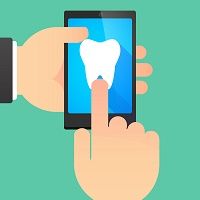Texting App Fosters Dental Effectiveness and Efficiencies
Smartphones have penetrated just about every aspect of our lives, except when it comes to patient care, where HIPAA regulations make the technology problematic. Now, a new secure texting application is helping to change that.

Text messaging is simple. It’s quick, easy, and portable. But when applies to dentistry, “simple” isn’t enough. It also must be secure.
That’s where Awrel, a Boston-based tech startup, comes in. The company has launched a HIPAA-compliant texting application it hopes will streamline the workflow of America’s dental offices.
“We provide the opportunity for a very simple and cost effective method to communicate between sectors, and with laboratories,” says Arnold Rosen, DDS, MBA, Awrel and CEO. “If Tom Brady had used our texting application instead of using his phone system, this issue of them wanting and needing his phone would not have been important because there is no information that resides on the phone in a HIPAA compliant application.”
By Dentists, For Dentists
Rosen explains that the Awrel solution provides functionality to intuitively create custom platforms for individuals and groups to exchange and store information, images, and documents. As such, a dentist can benefit from specialty consultation at the point of patient care, or from real-time interaction with a technician creating an implant or cosmetic prosthesis.
“We’re increasing productivity from a quantitative and qualitative standpoint,” Rosen says.
For example, from a quantitative standpoint, texting is a method for communicating rapidly and in a simple manner. Rosen says the Awrel app combines this technology in an environment where groups can be formed and documents can be shared and stored.
“I might have a restorative dentist,” Rosen says. “Or I might have, as part of a multidisciplinary team, an orthodontist preparing something for implants. I may even engage a specialist from a dental device company, like an implant company. By having a texting environment to work in, there’s no delay in the speed of communication, which is something that people are anticipating these days. So from a quantitative standpoint you can compress time and increase access to information.”
From a qualitative perspective, Rosen points to the increase in digital dentistry that often requires dentists to view work in progress. He says that currently the majority of this work is being done in a non-HIPAA compliant manner through normal text messaging.
“For that reason, we have received a lot of interest from the laboratory industry, as well as dentists who communicate with labs,” he says. “Labs can work rapidly and not have interruptions in workflow.”
Streamlined Effect
In addition to avoiding workflow interruptions, Rosen says the new application simplifies practice workflow. He recalls speaking with an oral surgeon who is part of a large surgical group. The group has been using a HIPAA-compliant email system, which lacks the simplicity of text messaging, to send x-rays and to communicate. As a result, staff is resistant to using the system because of its complexity.
But the new mobile and web app is not just a texting application. Rosen explains that it’s built on a business platform, and the plan going forward is to provide business solutions. This could come in the form of “smart forms” that facilitate the inputting of information that has to be sent to a lab.
“These will be resident and accessible as part of this texting environment,” he says.
Rosen points out that the platform the new application is built on includes connectivity to the internet, and the company plans to customize the application for use in a wide range of environments.
“This will provide an opportunity for a patient to have a tele-dental experience with their office,” he says. “That’s going to have significant value to the dental industry.”
Rosen further illustrates the benefits to dentists as well as patients. If a patient has an emergency because he or she breaks a tooth, they can use the application to take a photo with their phone and communicate how they’ve been compromised, both functionally and aesthetically, to the dentist—who in turn can be more efficient and productive by having that information in advance.
Opportunity Knocks
Rosen says he lectures frequently, and when he does, he talks about opportunity cost. And it amazes him that his colleagues have no idea what opportunity cost is.
“Opportunity cost is something that applies to the clinician and it applies to the patient” Rosen says. “When the patient comes in, if we did not communicate rapidly, and work in progress with the lab doesn’t show up, I lose productivity, and the patient has lost productivity. So there’s this opportunity cost that is seldom recognized, but probably is the most erosive aspect of the economics of a dental practice.”
The Awrel application, which was developed by dental professionals for use across the dental industry, is available from the App Store for iPhone users, and from the Google Play Store for Android users.
ACTIVA BioACTIVE Bulk Flow Marks Pulpdent’s First Major Product Release in 4 Years
December 12th 2024Next-generation bulk-fill dental restorative raises the standard of care for bulk-fill procedures by providing natural remineralization support, while also overcoming current bulk-fill limitations.